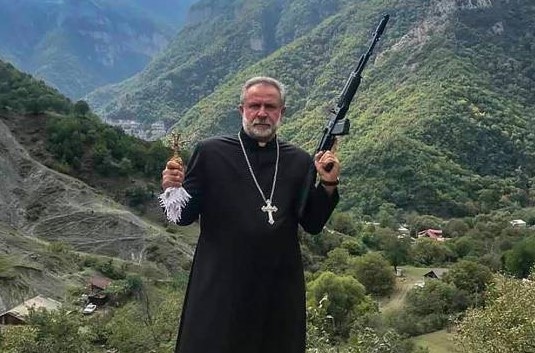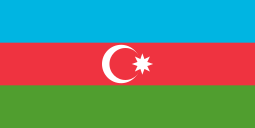
A priest with an unforgettable military background
26 November 2020
Almost immediately after the signing of the trilateral ceasefire statement in Karabakh, one of the popular topics in foreign media was the fate of the Khudavank (Dadivank) monastery complex. Many of them sound the alarm “The shrine is in danger”, meaning the return of Azerbaijanis to the Kalbajar region. As if this complex did not stand here for centuries under the same Azerbaijanis, but was built during the 27 years of occupation of the region by Armenia.

Who is this Hovhannes, who in another interview with the “Kommersant” newspaper, having forgotten how just a couple of months ago he posed against the background of the Kelbajar mountains with a cross in one hand and a machine gun in the other, advises us to rely on God, reads the proclamation: “Don't kill ... Don't say bad things ... Don't take what doesn't belong to you. "
Back in December 2019, one of the Armenian media christened this priest "Warrior of the Spirit". The publication reported that "along with the cross, Ter-Hovhannes took up arms from the very first days of the war, realizing that, hoping in God, one must also take care of security."
Grant (secular name of Hovhannes) was born in 1963 in Soviet Azerbaijan, the village of Vank, Kelbajar region. When mass rallies began in January 1988 in the Nagorno-Karabakh Autonomous Region (NKAO) demanding reunification with Armenia, he rode his motorcycle to Stepanakert almost every day. Shouted out on the central Lenin Square "Miatsum", slogans about "restoration of historical justice." The guy was so obsessed with the idea that, surprisingly, he called his second son, born in the same 1988, Artsakh.

Meanwhile, a real war was flaring up in Nagorno-Karabakh. Having embarked on his mission as a spiritual pastor, Ter-Hovhannes did not confine himself to prayer: “I could not bless the soldiers, call them to defend the Motherland, send them to the front, while I myself would only pray, hiding in a church. I could not help being an example, ”he says.
Ter-Hovhannes took up arms and personally went into battle. Then, leaving his machine gun at the entrance to the church, he went inside and prayed to God, asked for forgiveness and blessings ... “Apparently, God blessed,” the Armenian edition concludes, “Ter-Hovhannes served in the church during the day, prayed, and at night went to intelligence, was on duty in the trenches together with the defenders of the Motherland ... "
Further, another "heroic" act of the "warrior of the spirit" is reported, about how he first appeared in the monastery, of which he is now the abbot: in early April 1993, "with the liberation" of Kelbajar, Father Hovhannes, together with the legendary Monte Melkonyan ( member of ASALA who fought in Lebanon, carried out terrorist attacks in Rome and Athens, arrested in Paris, expelled from France - ed.), Norayr Danielyan (a militant arrested and sentenced to 10 years by the Azerbaijani authorities in 1990, subsequently exchanged for a group of prisoners - ed. .), other brave commanders, among the first entered the territory of Dadivank.
Many years later (2015) Pargev Srbazan called on Ter-Hovhannes to carry out a new mission - the revival of the shrine of Karvachar(by this time, the Armenians had already renamed Kelbajar - ed.), conquered with his active participation - the Khudavank monastery, which was also given a different name.
I don’t know what kind of spirituality people, who in this way create shrines for themselves, seizing and appropriating other people's religious monuments, declaring them to be their historical heritage, should have. Nor do I understand the journalists of those reputable foreign media outlets who glorify the “peaceful abbot” without bothering to at least find out something about his “glorious” military past on the Internet.
But here's what I want to remind you: in April 1993, the Armenian soldiers who broke into Kelbajar, in the forefront of which, as it turns out, was Priest Hovhannes, expelled 44,000 Azerbaijanis from there within 10 hours. (Watch the video below, maybe you will see our "peaceful clergyman" too?) And Azerbaijan gave 4 thousand Armenians illegally settled in Kelbajar since then in November 2020 two weeks to leave, then at the request of the opposite side extended the period to 25 days. I think that only Russian mediating peacekeepers, under whose control Khudavank still remains, can answer the question why the Armenian side needed this extra time? By the way, they did not benefit Father Hovhannes. Ten days ago he was going to leave for Yerevan, and now he is not only determined to continue the service, but also asks his interlocutor from “Kommersant”: "Why do Azerbaijanis come here at all?"
Author: Aykhan
Translator: Gulnara Rahimova












